Analyzing Sustainability: Indicators, Systems, and Resilience
VerifiedAdded on 2023/06/11
|10
|3121
|218
Homework Assignment
AI Summary
This assignment delves into various aspects of sustainability, examining the value of sustainability indicators across government, business, and civil society. It explores the vulnerabilities within the global food system, highlighting areas lacking resilience, particularly in biophysical capacity in countries like Africa. The assignment discusses the importance of social sustainability in implementing environmental proposals, emphasizing the role of local governments in achieving sustainability goals. It analyzes the shortcomings of historical community education programs in effecting behavioral changes, and identifies exciting innovations in the business sector. The solutions distinguish between systemic and behavioral change approaches for household sustainability and suggests ways to build resilience into the mainstream food system in Australia, drawing on the work of Walker and Salt.
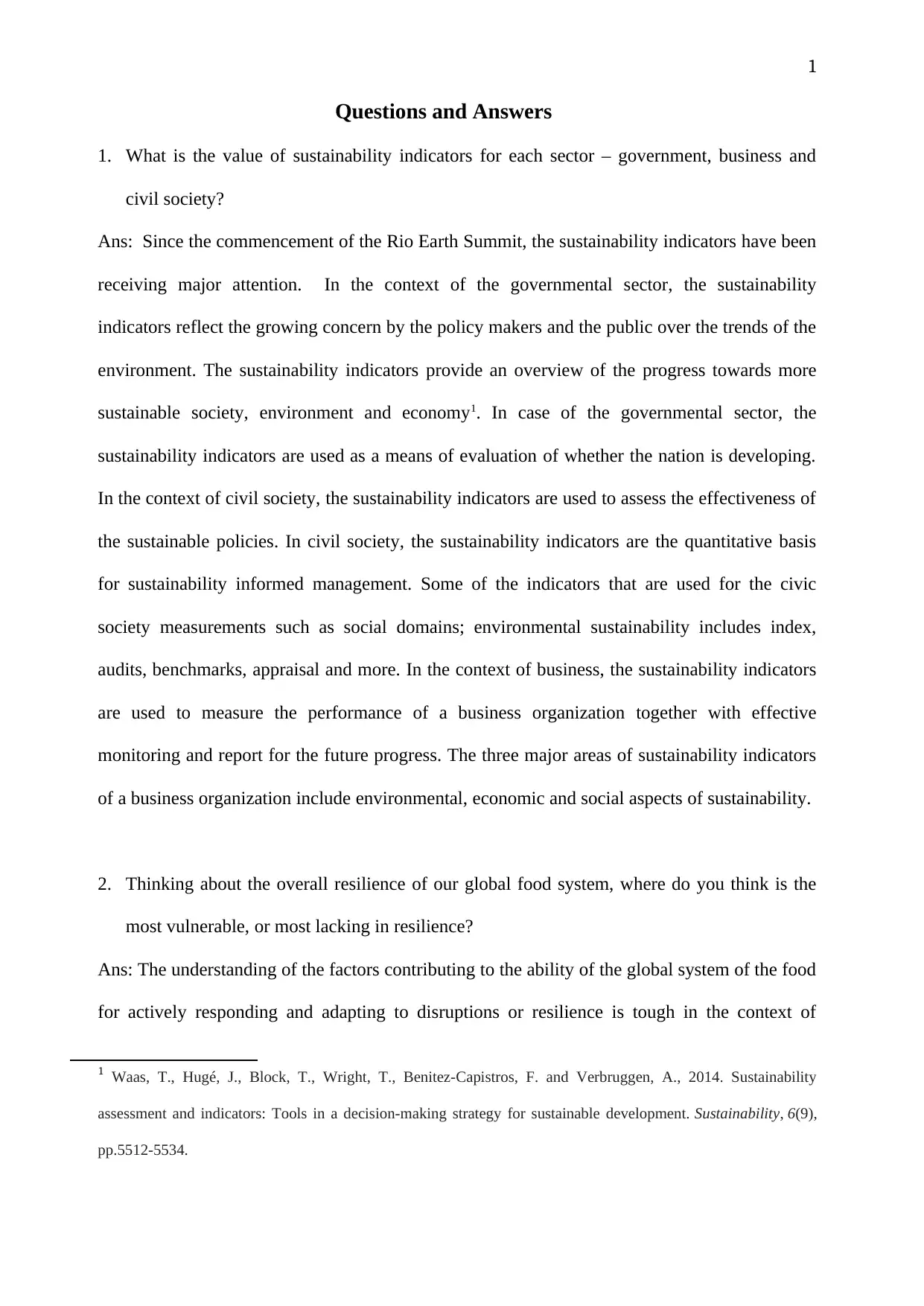
1
Questions and Answers
1. What is the value of sustainability indicators for each sector – government, business and
civil society?
Ans: Since the commencement of the Rio Earth Summit, the sustainability indicators have been
receiving major attention. In the context of the governmental sector, the sustainability
indicators reflect the growing concern by the policy makers and the public over the trends of the
environment. The sustainability indicators provide an overview of the progress towards more
sustainable society, environment and economy1. In case of the governmental sector, the
sustainability indicators are used as a means of evaluation of whether the nation is developing.
In the context of civil society, the sustainability indicators are used to assess the effectiveness of
the sustainable policies. In civil society, the sustainability indicators are the quantitative basis
for sustainability informed management. Some of the indicators that are used for the civic
society measurements such as social domains; environmental sustainability includes index,
audits, benchmarks, appraisal and more. In the context of business, the sustainability indicators
are used to measure the performance of a business organization together with effective
monitoring and report for the future progress. The three major areas of sustainability indicators
of a business organization include environmental, economic and social aspects of sustainability.
2. Thinking about the overall resilience of our global food system, where do you think is the
most vulnerable, or most lacking in resilience?
Ans: The understanding of the factors contributing to the ability of the global system of the food
for actively responding and adapting to disruptions or resilience is tough in the context of
1 Waas, T., Hugé, J., Block, T., Wright, T., Benitez-Capistros, F. and Verbruggen, A., 2014. Sustainability
assessment and indicators: Tools in a decision-making strategy for sustainable development. Sustainability, 6(9),
pp.5512-5534.
Questions and Answers
1. What is the value of sustainability indicators for each sector – government, business and
civil society?
Ans: Since the commencement of the Rio Earth Summit, the sustainability indicators have been
receiving major attention. In the context of the governmental sector, the sustainability
indicators reflect the growing concern by the policy makers and the public over the trends of the
environment. The sustainability indicators provide an overview of the progress towards more
sustainable society, environment and economy1. In case of the governmental sector, the
sustainability indicators are used as a means of evaluation of whether the nation is developing.
In the context of civil society, the sustainability indicators are used to assess the effectiveness of
the sustainable policies. In civil society, the sustainability indicators are the quantitative basis
for sustainability informed management. Some of the indicators that are used for the civic
society measurements such as social domains; environmental sustainability includes index,
audits, benchmarks, appraisal and more. In the context of business, the sustainability indicators
are used to measure the performance of a business organization together with effective
monitoring and report for the future progress. The three major areas of sustainability indicators
of a business organization include environmental, economic and social aspects of sustainability.
2. Thinking about the overall resilience of our global food system, where do you think is the
most vulnerable, or most lacking in resilience?
Ans: The understanding of the factors contributing to the ability of the global system of the food
for actively responding and adapting to disruptions or resilience is tough in the context of
1 Waas, T., Hugé, J., Block, T., Wright, T., Benitez-Capistros, F. and Verbruggen, A., 2014. Sustainability
assessment and indicators: Tools in a decision-making strategy for sustainable development. Sustainability, 6(9),
pp.5512-5534.
Paraphrase This Document
Need a fresh take? Get an instant paraphrase of this document with our AI Paraphraser
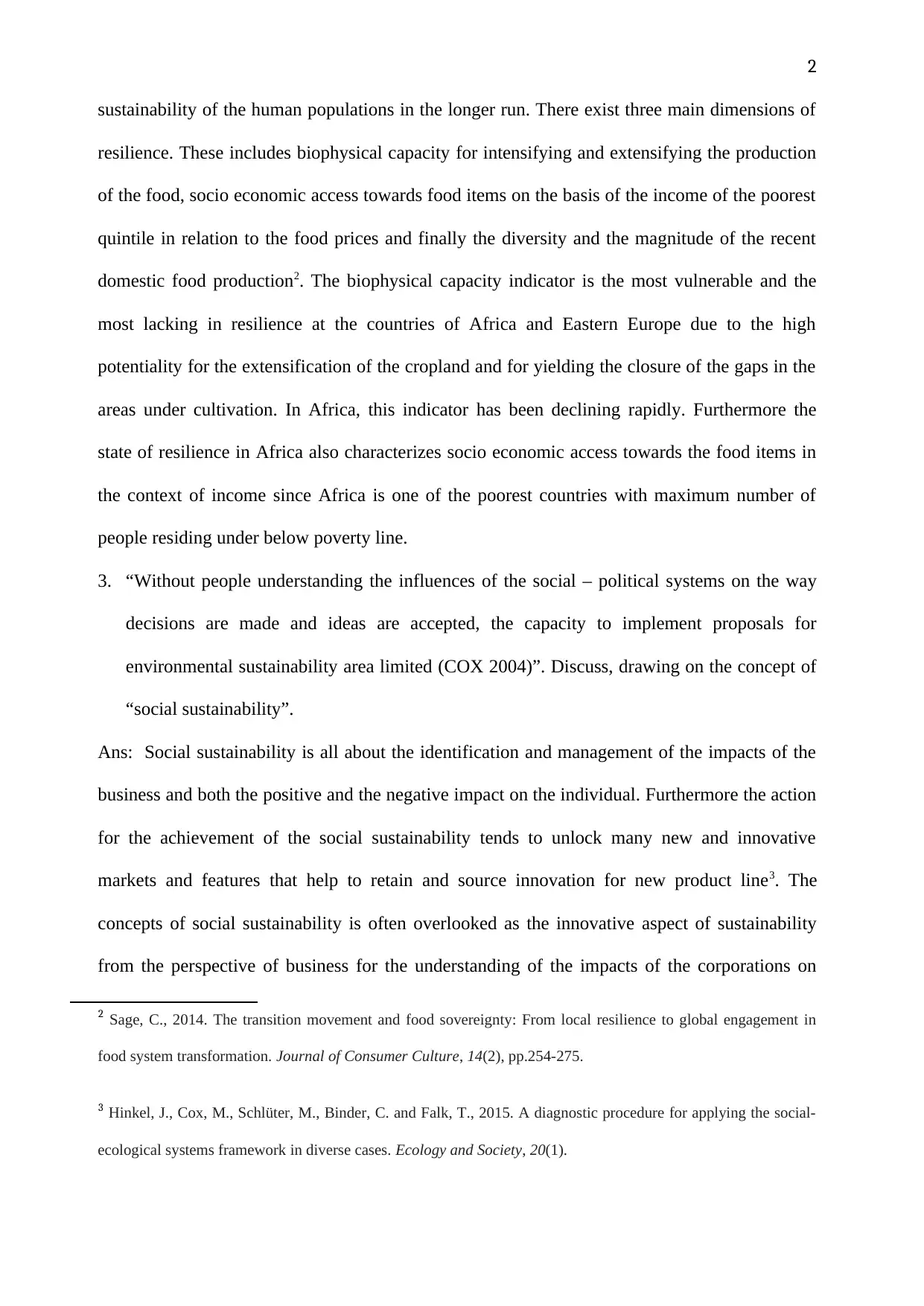
2
sustainability of the human populations in the longer run. There exist three main dimensions of
resilience. These includes biophysical capacity for intensifying and extensifying the production
of the food, socio economic access towards food items on the basis of the income of the poorest
quintile in relation to the food prices and finally the diversity and the magnitude of the recent
domestic food production2. The biophysical capacity indicator is the most vulnerable and the
most lacking in resilience at the countries of Africa and Eastern Europe due to the high
potentiality for the extensification of the cropland and for yielding the closure of the gaps in the
areas under cultivation. In Africa, this indicator has been declining rapidly. Furthermore the
state of resilience in Africa also characterizes socio economic access towards the food items in
the context of income since Africa is one of the poorest countries with maximum number of
people residing under below poverty line.
3. “Without people understanding the influences of the social – political systems on the way
decisions are made and ideas are accepted, the capacity to implement proposals for
environmental sustainability area limited (COX 2004)”. Discuss, drawing on the concept of
“social sustainability”.
Ans: Social sustainability is all about the identification and management of the impacts of the
business and both the positive and the negative impact on the individual. Furthermore the action
for the achievement of the social sustainability tends to unlock many new and innovative
markets and features that help to retain and source innovation for new product line3. The
concepts of social sustainability is often overlooked as the innovative aspect of sustainability
from the perspective of business for the understanding of the impacts of the corporations on
2 Sage, C., 2014. The transition movement and food sovereignty: From local resilience to global engagement in
food system transformation. Journal of Consumer Culture, 14(2), pp.254-275.
3 Hinkel, J., Cox, M., Schlüter, M., Binder, C. and Falk, T., 2015. A diagnostic procedure for applying the social-
ecological systems framework in diverse cases. Ecology and Society, 20(1).
sustainability of the human populations in the longer run. There exist three main dimensions of
resilience. These includes biophysical capacity for intensifying and extensifying the production
of the food, socio economic access towards food items on the basis of the income of the poorest
quintile in relation to the food prices and finally the diversity and the magnitude of the recent
domestic food production2. The biophysical capacity indicator is the most vulnerable and the
most lacking in resilience at the countries of Africa and Eastern Europe due to the high
potentiality for the extensification of the cropland and for yielding the closure of the gaps in the
areas under cultivation. In Africa, this indicator has been declining rapidly. Furthermore the
state of resilience in Africa also characterizes socio economic access towards the food items in
the context of income since Africa is one of the poorest countries with maximum number of
people residing under below poverty line.
3. “Without people understanding the influences of the social – political systems on the way
decisions are made and ideas are accepted, the capacity to implement proposals for
environmental sustainability area limited (COX 2004)”. Discuss, drawing on the concept of
“social sustainability”.
Ans: Social sustainability is all about the identification and management of the impacts of the
business and both the positive and the negative impact on the individual. Furthermore the action
for the achievement of the social sustainability tends to unlock many new and innovative
markets and features that help to retain and source innovation for new product line3. The
concepts of social sustainability is often overlooked as the innovative aspect of sustainability
from the perspective of business for the understanding of the impacts of the corporations on
2 Sage, C., 2014. The transition movement and food sovereignty: From local resilience to global engagement in
food system transformation. Journal of Consumer Culture, 14(2), pp.254-275.
3 Hinkel, J., Cox, M., Schlüter, M., Binder, C. and Falk, T., 2015. A diagnostic procedure for applying the social-
ecological systems framework in diverse cases. Ecology and Society, 20(1).
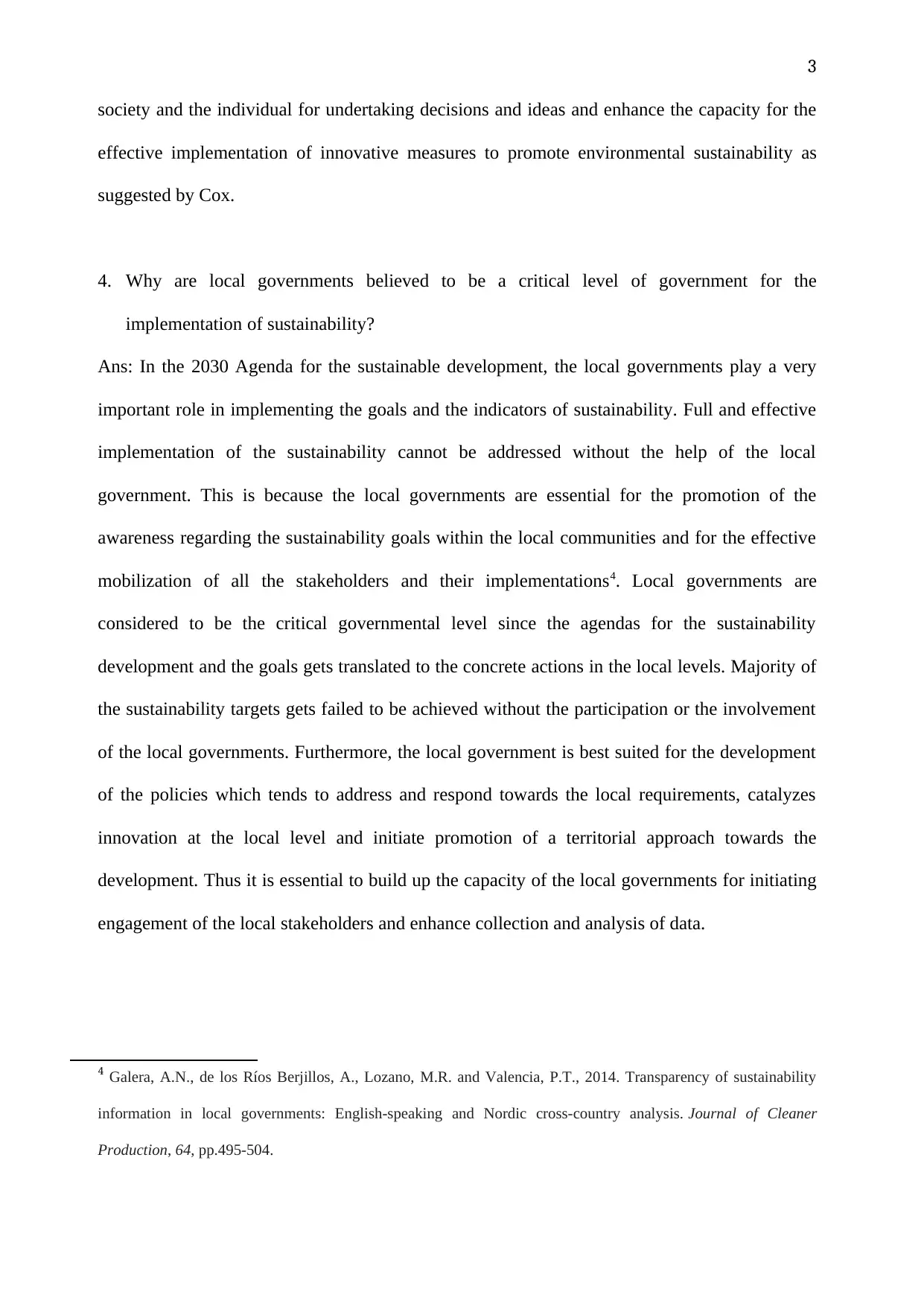
3
society and the individual for undertaking decisions and ideas and enhance the capacity for the
effective implementation of innovative measures to promote environmental sustainability as
suggested by Cox.
4. Why are local governments believed to be a critical level of government for the
implementation of sustainability?
Ans: In the 2030 Agenda for the sustainable development, the local governments play a very
important role in implementing the goals and the indicators of sustainability. Full and effective
implementation of the sustainability cannot be addressed without the help of the local
government. This is because the local governments are essential for the promotion of the
awareness regarding the sustainability goals within the local communities and for the effective
mobilization of all the stakeholders and their implementations4. Local governments are
considered to be the critical governmental level since the agendas for the sustainability
development and the goals gets translated to the concrete actions in the local levels. Majority of
the sustainability targets gets failed to be achieved without the participation or the involvement
of the local governments. Furthermore, the local government is best suited for the development
of the policies which tends to address and respond towards the local requirements, catalyzes
innovation at the local level and initiate promotion of a territorial approach towards the
development. Thus it is essential to build up the capacity of the local governments for initiating
engagement of the local stakeholders and enhance collection and analysis of data.
4 Galera, A.N., de los Ríos Berjillos, A., Lozano, M.R. and Valencia, P.T., 2014. Transparency of sustainability
information in local governments: English-speaking and Nordic cross-country analysis. Journal of Cleaner
Production, 64, pp.495-504.
society and the individual for undertaking decisions and ideas and enhance the capacity for the
effective implementation of innovative measures to promote environmental sustainability as
suggested by Cox.
4. Why are local governments believed to be a critical level of government for the
implementation of sustainability?
Ans: In the 2030 Agenda for the sustainable development, the local governments play a very
important role in implementing the goals and the indicators of sustainability. Full and effective
implementation of the sustainability cannot be addressed without the help of the local
government. This is because the local governments are essential for the promotion of the
awareness regarding the sustainability goals within the local communities and for the effective
mobilization of all the stakeholders and their implementations4. Local governments are
considered to be the critical governmental level since the agendas for the sustainability
development and the goals gets translated to the concrete actions in the local levels. Majority of
the sustainability targets gets failed to be achieved without the participation or the involvement
of the local governments. Furthermore, the local government is best suited for the development
of the policies which tends to address and respond towards the local requirements, catalyzes
innovation at the local level and initiate promotion of a territorial approach towards the
development. Thus it is essential to build up the capacity of the local governments for initiating
engagement of the local stakeholders and enhance collection and analysis of data.
4 Galera, A.N., de los Ríos Berjillos, A., Lozano, M.R. and Valencia, P.T., 2014. Transparency of sustainability
information in local governments: English-speaking and Nordic cross-country analysis. Journal of Cleaner
Production, 64, pp.495-504.
⊘ This is a preview!⊘
Do you want full access?
Subscribe today to unlock all pages.

Trusted by 1+ million students worldwide
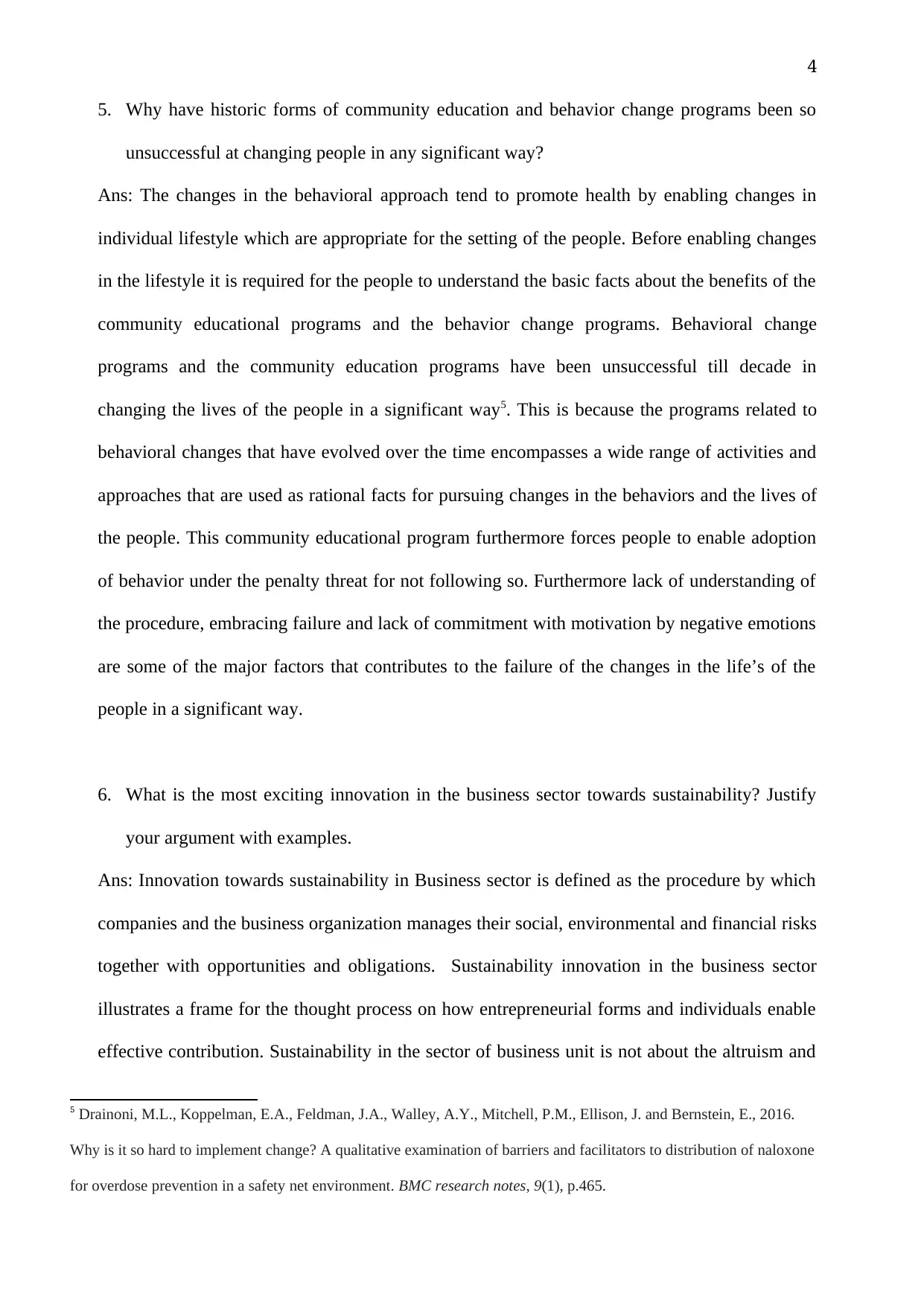
4
5. Why have historic forms of community education and behavior change programs been so
unsuccessful at changing people in any significant way?
Ans: The changes in the behavioral approach tend to promote health by enabling changes in
individual lifestyle which are appropriate for the setting of the people. Before enabling changes
in the lifestyle it is required for the people to understand the basic facts about the benefits of the
community educational programs and the behavior change programs. Behavioral change
programs and the community education programs have been unsuccessful till decade in
changing the lives of the people in a significant way5. This is because the programs related to
behavioral changes that have evolved over the time encompasses a wide range of activities and
approaches that are used as rational facts for pursuing changes in the behaviors and the lives of
the people. This community educational program furthermore forces people to enable adoption
of behavior under the penalty threat for not following so. Furthermore lack of understanding of
the procedure, embracing failure and lack of commitment with motivation by negative emotions
are some of the major factors that contributes to the failure of the changes in the life’s of the
people in a significant way.
6. What is the most exciting innovation in the business sector towards sustainability? Justify
your argument with examples.
Ans: Innovation towards sustainability in Business sector is defined as the procedure by which
companies and the business organization manages their social, environmental and financial risks
together with opportunities and obligations. Sustainability innovation in the business sector
illustrates a frame for the thought process on how entrepreneurial forms and individuals enable
effective contribution. Sustainability in the sector of business unit is not about the altruism and
5 Drainoni, M.L., Koppelman, E.A., Feldman, J.A., Walley, A.Y., Mitchell, P.M., Ellison, J. and Bernstein, E., 2016.
Why is it so hard to implement change? A qualitative examination of barriers and facilitators to distribution of naloxone
for overdose prevention in a safety net environment. BMC research notes, 9(1), p.465.
5. Why have historic forms of community education and behavior change programs been so
unsuccessful at changing people in any significant way?
Ans: The changes in the behavioral approach tend to promote health by enabling changes in
individual lifestyle which are appropriate for the setting of the people. Before enabling changes
in the lifestyle it is required for the people to understand the basic facts about the benefits of the
community educational programs and the behavior change programs. Behavioral change
programs and the community education programs have been unsuccessful till decade in
changing the lives of the people in a significant way5. This is because the programs related to
behavioral changes that have evolved over the time encompasses a wide range of activities and
approaches that are used as rational facts for pursuing changes in the behaviors and the lives of
the people. This community educational program furthermore forces people to enable adoption
of behavior under the penalty threat for not following so. Furthermore lack of understanding of
the procedure, embracing failure and lack of commitment with motivation by negative emotions
are some of the major factors that contributes to the failure of the changes in the life’s of the
people in a significant way.
6. What is the most exciting innovation in the business sector towards sustainability? Justify
your argument with examples.
Ans: Innovation towards sustainability in Business sector is defined as the procedure by which
companies and the business organization manages their social, environmental and financial risks
together with opportunities and obligations. Sustainability innovation in the business sector
illustrates a frame for the thought process on how entrepreneurial forms and individuals enable
effective contribution. Sustainability in the sector of business unit is not about the altruism and
5 Drainoni, M.L., Koppelman, E.A., Feldman, J.A., Walley, A.Y., Mitchell, P.M., Ellison, J. and Bernstein, E., 2016.
Why is it so hard to implement change? A qualitative examination of barriers and facilitators to distribution of naloxone
for overdose prevention in a safety net environment. BMC research notes, 9(1), p.465.
Paraphrase This Document
Need a fresh take? Get an instant paraphrase of this document with our AI Paraphraser
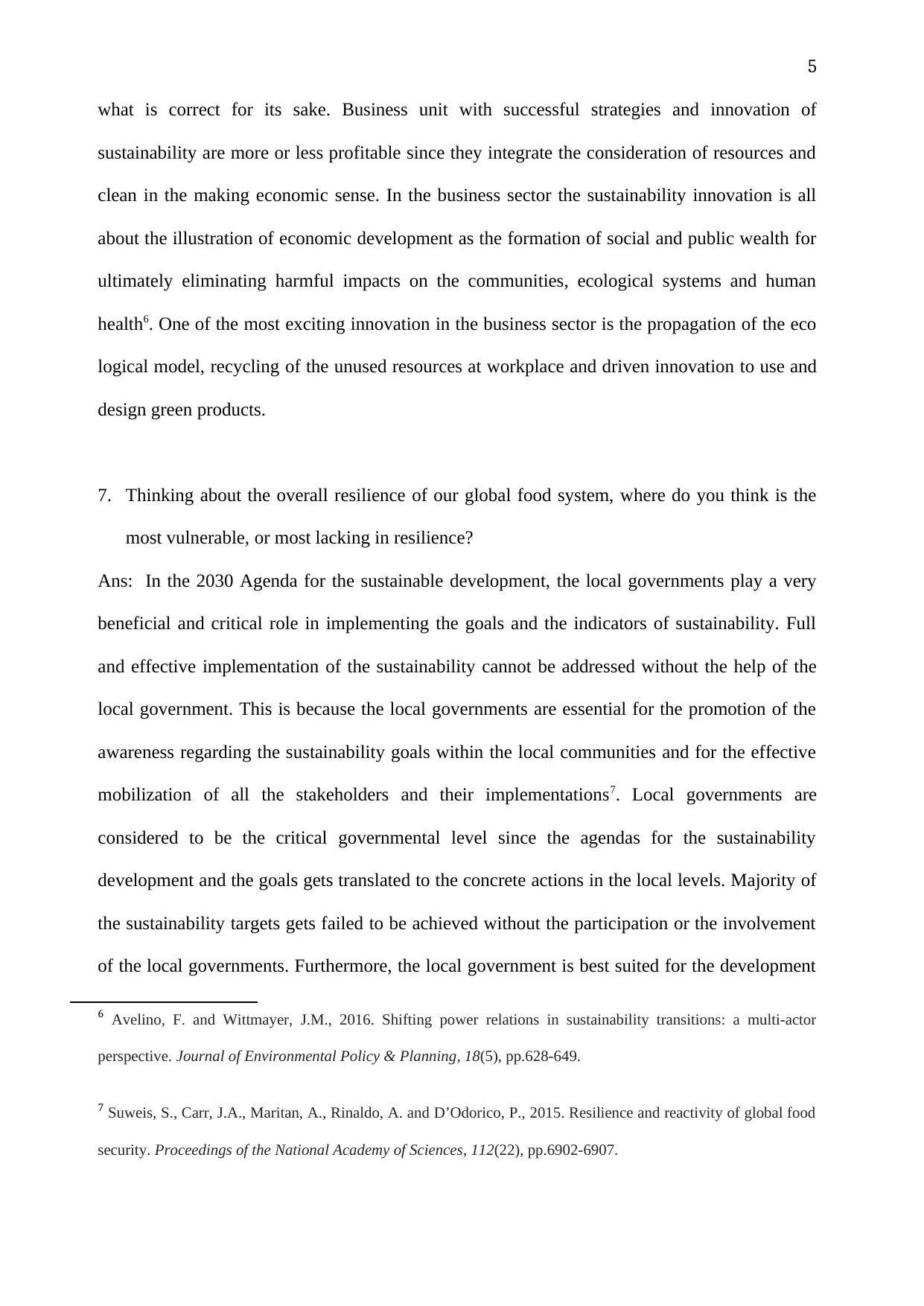
5
what is correct for its sake. Business unit with successful strategies and innovation of
sustainability are more or less profitable since they integrate the consideration of resources and
clean in the making economic sense. In the business sector the sustainability innovation is all
about the illustration of economic development as the formation of social and public wealth for
ultimately eliminating harmful impacts on the communities, ecological systems and human
health6. One of the most exciting innovation in the business sector is the propagation of the eco
logical model, recycling of the unused resources at workplace and driven innovation to use and
design green products.
7. Thinking about the overall resilience of our global food system, where do you think is the
most vulnerable, or most lacking in resilience?
Ans: In the 2030 Agenda for the sustainable development, the local governments play a very
beneficial and critical role in implementing the goals and the indicators of sustainability. Full
and effective implementation of the sustainability cannot be addressed without the help of the
local government. This is because the local governments are essential for the promotion of the
awareness regarding the sustainability goals within the local communities and for the effective
mobilization of all the stakeholders and their implementations7. Local governments are
considered to be the critical governmental level since the agendas for the sustainability
development and the goals gets translated to the concrete actions in the local levels. Majority of
the sustainability targets gets failed to be achieved without the participation or the involvement
of the local governments. Furthermore, the local government is best suited for the development
6 Avelino, F. and Wittmayer, J.M., 2016. Shifting power relations in sustainability transitions: a multi-actor
perspective. Journal of Environmental Policy & Planning, 18(5), pp.628-649.
7 Suweis, S., Carr, J.A., Maritan, A., Rinaldo, A. and D’Odorico, P., 2015. Resilience and reactivity of global food
security. Proceedings of the National Academy of Sciences, 112(22), pp.6902-6907.
what is correct for its sake. Business unit with successful strategies and innovation of
sustainability are more or less profitable since they integrate the consideration of resources and
clean in the making economic sense. In the business sector the sustainability innovation is all
about the illustration of economic development as the formation of social and public wealth for
ultimately eliminating harmful impacts on the communities, ecological systems and human
health6. One of the most exciting innovation in the business sector is the propagation of the eco
logical model, recycling of the unused resources at workplace and driven innovation to use and
design green products.
7. Thinking about the overall resilience of our global food system, where do you think is the
most vulnerable, or most lacking in resilience?
Ans: In the 2030 Agenda for the sustainable development, the local governments play a very
beneficial and critical role in implementing the goals and the indicators of sustainability. Full
and effective implementation of the sustainability cannot be addressed without the help of the
local government. This is because the local governments are essential for the promotion of the
awareness regarding the sustainability goals within the local communities and for the effective
mobilization of all the stakeholders and their implementations7. Local governments are
considered to be the critical governmental level since the agendas for the sustainability
development and the goals gets translated to the concrete actions in the local levels. Majority of
the sustainability targets gets failed to be achieved without the participation or the involvement
of the local governments. Furthermore, the local government is best suited for the development
6 Avelino, F. and Wittmayer, J.M., 2016. Shifting power relations in sustainability transitions: a multi-actor
perspective. Journal of Environmental Policy & Planning, 18(5), pp.628-649.
7 Suweis, S., Carr, J.A., Maritan, A., Rinaldo, A. and D’Odorico, P., 2015. Resilience and reactivity of global food
security. Proceedings of the National Academy of Sciences, 112(22), pp.6902-6907.
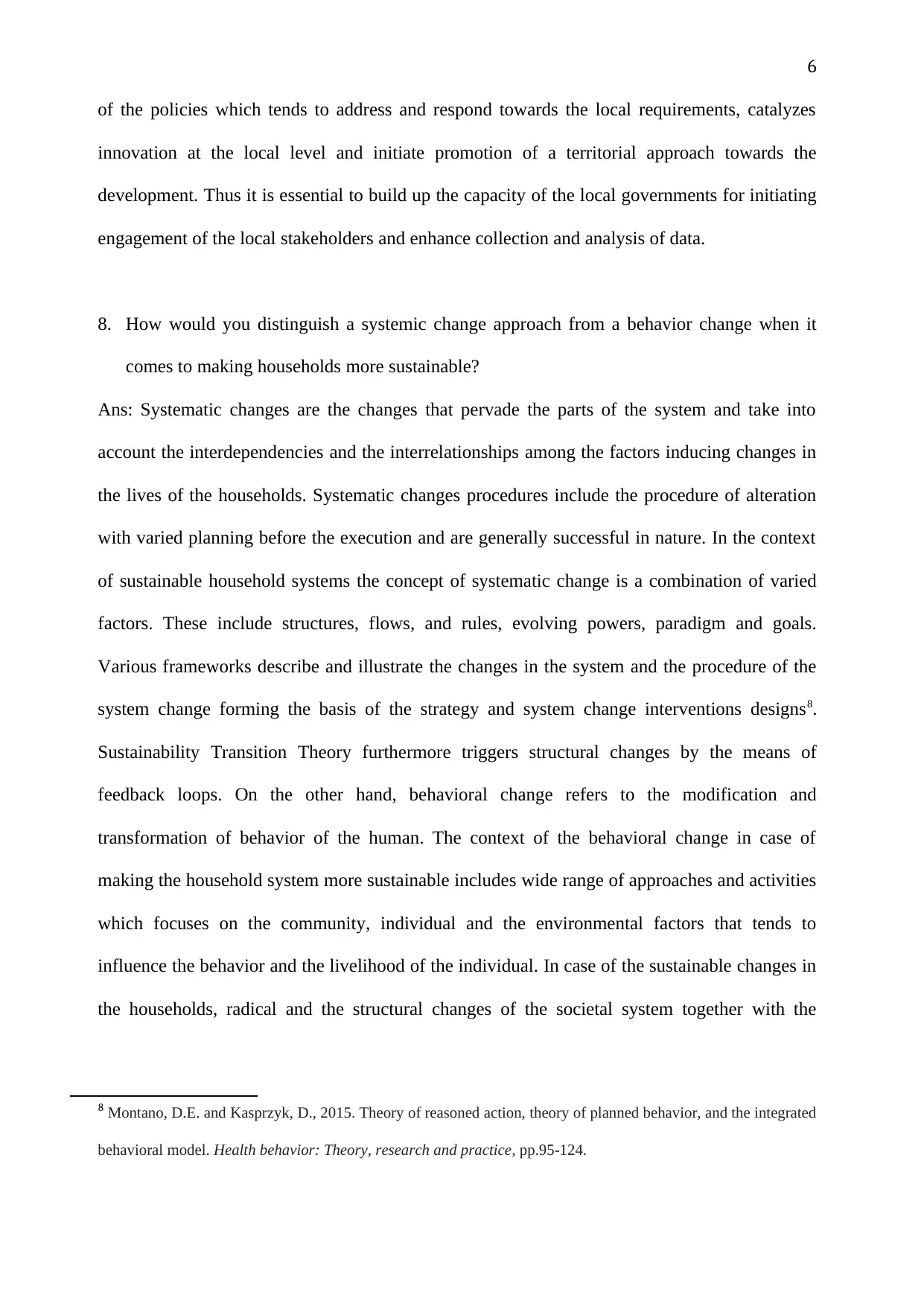
6
of the policies which tends to address and respond towards the local requirements, catalyzes
innovation at the local level and initiate promotion of a territorial approach towards the
development. Thus it is essential to build up the capacity of the local governments for initiating
engagement of the local stakeholders and enhance collection and analysis of data.
8. How would you distinguish a systemic change approach from a behavior change when it
comes to making households more sustainable?
Ans: Systematic changes are the changes that pervade the parts of the system and take into
account the interdependencies and the interrelationships among the factors inducing changes in
the lives of the households. Systematic changes procedures include the procedure of alteration
with varied planning before the execution and are generally successful in nature. In the context
of sustainable household systems the concept of systematic change is a combination of varied
factors. These include structures, flows, and rules, evolving powers, paradigm and goals.
Various frameworks describe and illustrate the changes in the system and the procedure of the
system change forming the basis of the strategy and system change interventions designs8.
Sustainability Transition Theory furthermore triggers structural changes by the means of
feedback loops. On the other hand, behavioral change refers to the modification and
transformation of behavior of the human. The context of the behavioral change in case of
making the household system more sustainable includes wide range of approaches and activities
which focuses on the community, individual and the environmental factors that tends to
influence the behavior and the livelihood of the individual. In case of the sustainable changes in
the households, radical and the structural changes of the societal system together with the
8 Montano, D.E. and Kasprzyk, D., 2015. Theory of reasoned action, theory of planned behavior, and the integrated
behavioral model. Health behavior: Theory, research and practice, pp.95-124.
of the policies which tends to address and respond towards the local requirements, catalyzes
innovation at the local level and initiate promotion of a territorial approach towards the
development. Thus it is essential to build up the capacity of the local governments for initiating
engagement of the local stakeholders and enhance collection and analysis of data.
8. How would you distinguish a systemic change approach from a behavior change when it
comes to making households more sustainable?
Ans: Systematic changes are the changes that pervade the parts of the system and take into
account the interdependencies and the interrelationships among the factors inducing changes in
the lives of the households. Systematic changes procedures include the procedure of alteration
with varied planning before the execution and are generally successful in nature. In the context
of sustainable household systems the concept of systematic change is a combination of varied
factors. These include structures, flows, and rules, evolving powers, paradigm and goals.
Various frameworks describe and illustrate the changes in the system and the procedure of the
system change forming the basis of the strategy and system change interventions designs8.
Sustainability Transition Theory furthermore triggers structural changes by the means of
feedback loops. On the other hand, behavioral change refers to the modification and
transformation of behavior of the human. The context of the behavioral change in case of
making the household system more sustainable includes wide range of approaches and activities
which focuses on the community, individual and the environmental factors that tends to
influence the behavior and the livelihood of the individual. In case of the sustainable changes in
the households, radical and the structural changes of the societal system together with the
8 Montano, D.E. and Kasprzyk, D., 2015. Theory of reasoned action, theory of planned behavior, and the integrated
behavioral model. Health behavior: Theory, research and practice, pp.95-124.
⊘ This is a preview!⊘
Do you want full access?
Subscribe today to unlock all pages.

Trusted by 1+ million students worldwide
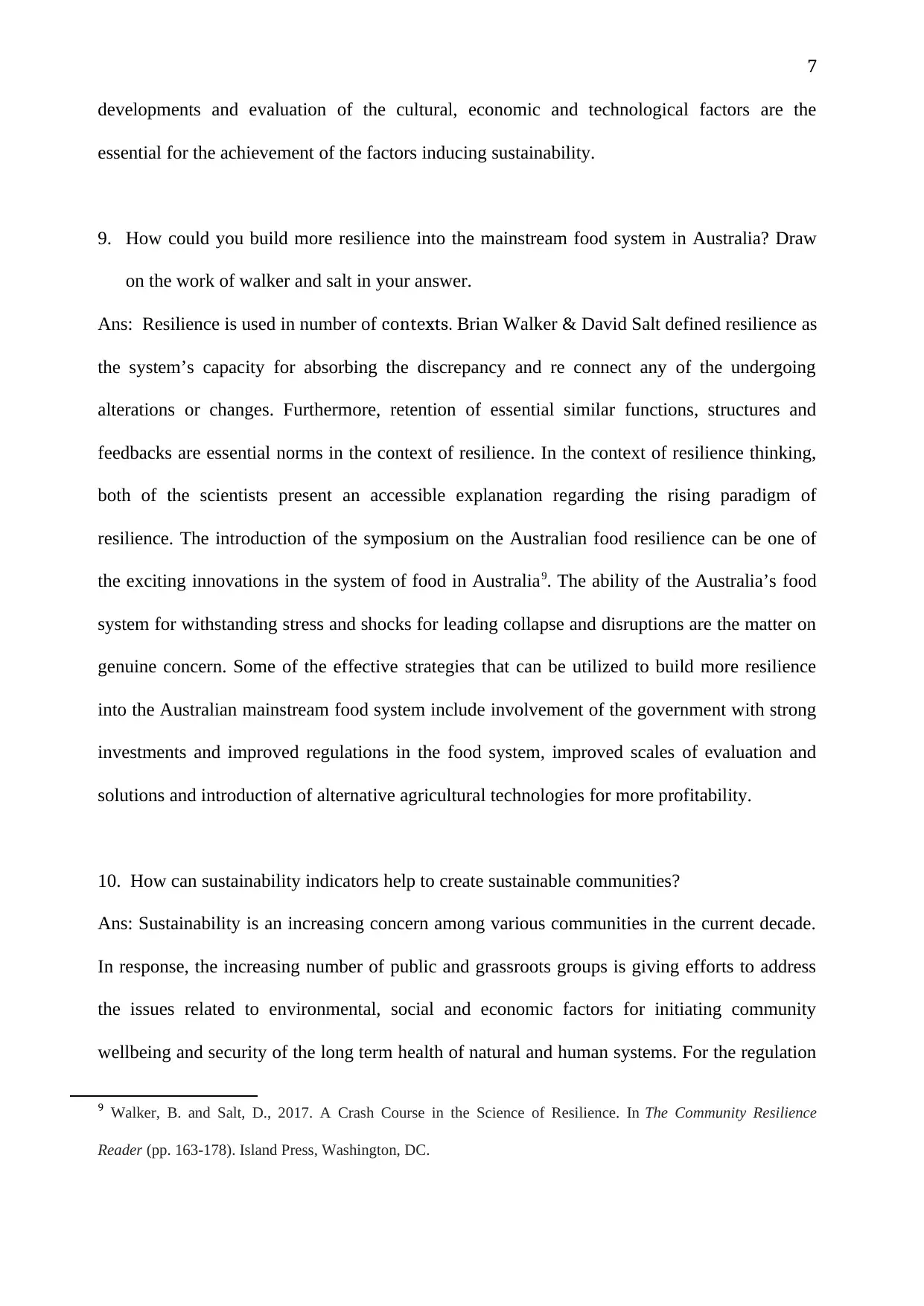
7
developments and evaluation of the cultural, economic and technological factors are the
essential for the achievement of the factors inducing sustainability.
9. How could you build more resilience into the mainstream food system in Australia? Draw
on the work of walker and salt in your answer.
Ans: Resilience is used in number of contexts. Brian Walker & David Salt defined resilience as
the system’s capacity for absorbing the discrepancy and re connect any of the undergoing
alterations or changes. Furthermore, retention of essential similar functions, structures and
feedbacks are essential norms in the context of resilience. In the context of resilience thinking,
both of the scientists present an accessible explanation regarding the rising paradigm of
resilience. The introduction of the symposium on the Australian food resilience can be one of
the exciting innovations in the system of food in Australia9. The ability of the Australia’s food
system for withstanding stress and shocks for leading collapse and disruptions are the matter on
genuine concern. Some of the effective strategies that can be utilized to build more resilience
into the Australian mainstream food system include involvement of the government with strong
investments and improved regulations in the food system, improved scales of evaluation and
solutions and introduction of alternative agricultural technologies for more profitability.
10. How can sustainability indicators help to create sustainable communities?
Ans: Sustainability is an increasing concern among various communities in the current decade.
In response, the increasing number of public and grassroots groups is giving efforts to address
the issues related to environmental, social and economic factors for initiating community
wellbeing and security of the long term health of natural and human systems. For the regulation
9 Walker, B. and Salt, D., 2017. A Crash Course in the Science of Resilience. In The Community Resilience
Reader (pp. 163-178). Island Press, Washington, DC.
developments and evaluation of the cultural, economic and technological factors are the
essential for the achievement of the factors inducing sustainability.
9. How could you build more resilience into the mainstream food system in Australia? Draw
on the work of walker and salt in your answer.
Ans: Resilience is used in number of contexts. Brian Walker & David Salt defined resilience as
the system’s capacity for absorbing the discrepancy and re connect any of the undergoing
alterations or changes. Furthermore, retention of essential similar functions, structures and
feedbacks are essential norms in the context of resilience. In the context of resilience thinking,
both of the scientists present an accessible explanation regarding the rising paradigm of
resilience. The introduction of the symposium on the Australian food resilience can be one of
the exciting innovations in the system of food in Australia9. The ability of the Australia’s food
system for withstanding stress and shocks for leading collapse and disruptions are the matter on
genuine concern. Some of the effective strategies that can be utilized to build more resilience
into the Australian mainstream food system include involvement of the government with strong
investments and improved regulations in the food system, improved scales of evaluation and
solutions and introduction of alternative agricultural technologies for more profitability.
10. How can sustainability indicators help to create sustainable communities?
Ans: Sustainability is an increasing concern among various communities in the current decade.
In response, the increasing number of public and grassroots groups is giving efforts to address
the issues related to environmental, social and economic factors for initiating community
wellbeing and security of the long term health of natural and human systems. For the regulation
9 Walker, B. and Salt, D., 2017. A Crash Course in the Science of Resilience. In The Community Resilience
Reader (pp. 163-178). Island Press, Washington, DC.
Paraphrase This Document
Need a fresh take? Get an instant paraphrase of this document with our AI Paraphraser
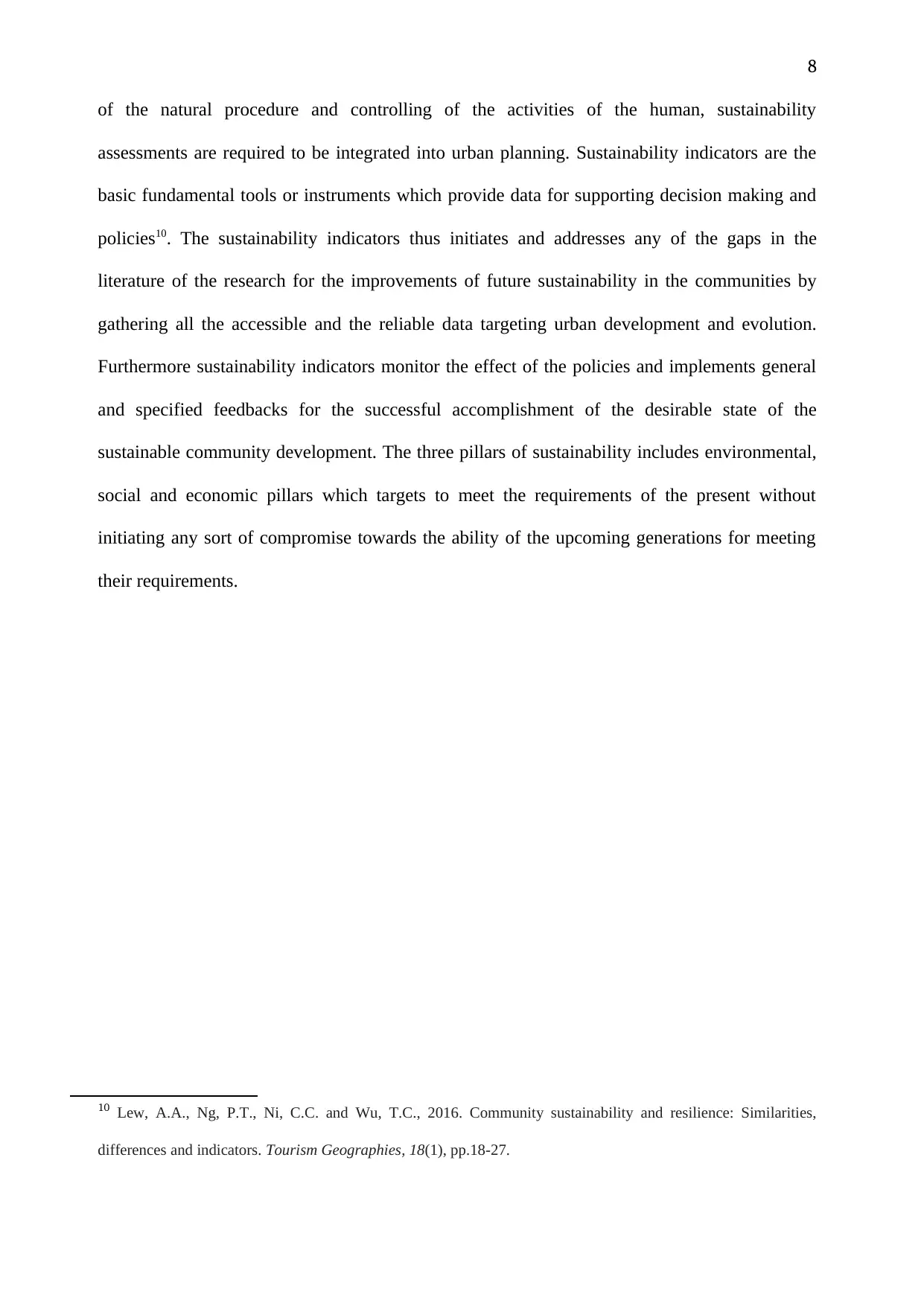
8
of the natural procedure and controlling of the activities of the human, sustainability
assessments are required to be integrated into urban planning. Sustainability indicators are the
basic fundamental tools or instruments which provide data for supporting decision making and
policies10. The sustainability indicators thus initiates and addresses any of the gaps in the
literature of the research for the improvements of future sustainability in the communities by
gathering all the accessible and the reliable data targeting urban development and evolution.
Furthermore sustainability indicators monitor the effect of the policies and implements general
and specified feedbacks for the successful accomplishment of the desirable state of the
sustainable community development. The three pillars of sustainability includes environmental,
social and economic pillars which targets to meet the requirements of the present without
initiating any sort of compromise towards the ability of the upcoming generations for meeting
their requirements.
10 Lew, A.A., Ng, P.T., Ni, C.C. and Wu, T.C., 2016. Community sustainability and resilience: Similarities,
differences and indicators. Tourism Geographies, 18(1), pp.18-27.
of the natural procedure and controlling of the activities of the human, sustainability
assessments are required to be integrated into urban planning. Sustainability indicators are the
basic fundamental tools or instruments which provide data for supporting decision making and
policies10. The sustainability indicators thus initiates and addresses any of the gaps in the
literature of the research for the improvements of future sustainability in the communities by
gathering all the accessible and the reliable data targeting urban development and evolution.
Furthermore sustainability indicators monitor the effect of the policies and implements general
and specified feedbacks for the successful accomplishment of the desirable state of the
sustainable community development. The three pillars of sustainability includes environmental,
social and economic pillars which targets to meet the requirements of the present without
initiating any sort of compromise towards the ability of the upcoming generations for meeting
their requirements.
10 Lew, A.A., Ng, P.T., Ni, C.C. and Wu, T.C., 2016. Community sustainability and resilience: Similarities,
differences and indicators. Tourism Geographies, 18(1), pp.18-27.
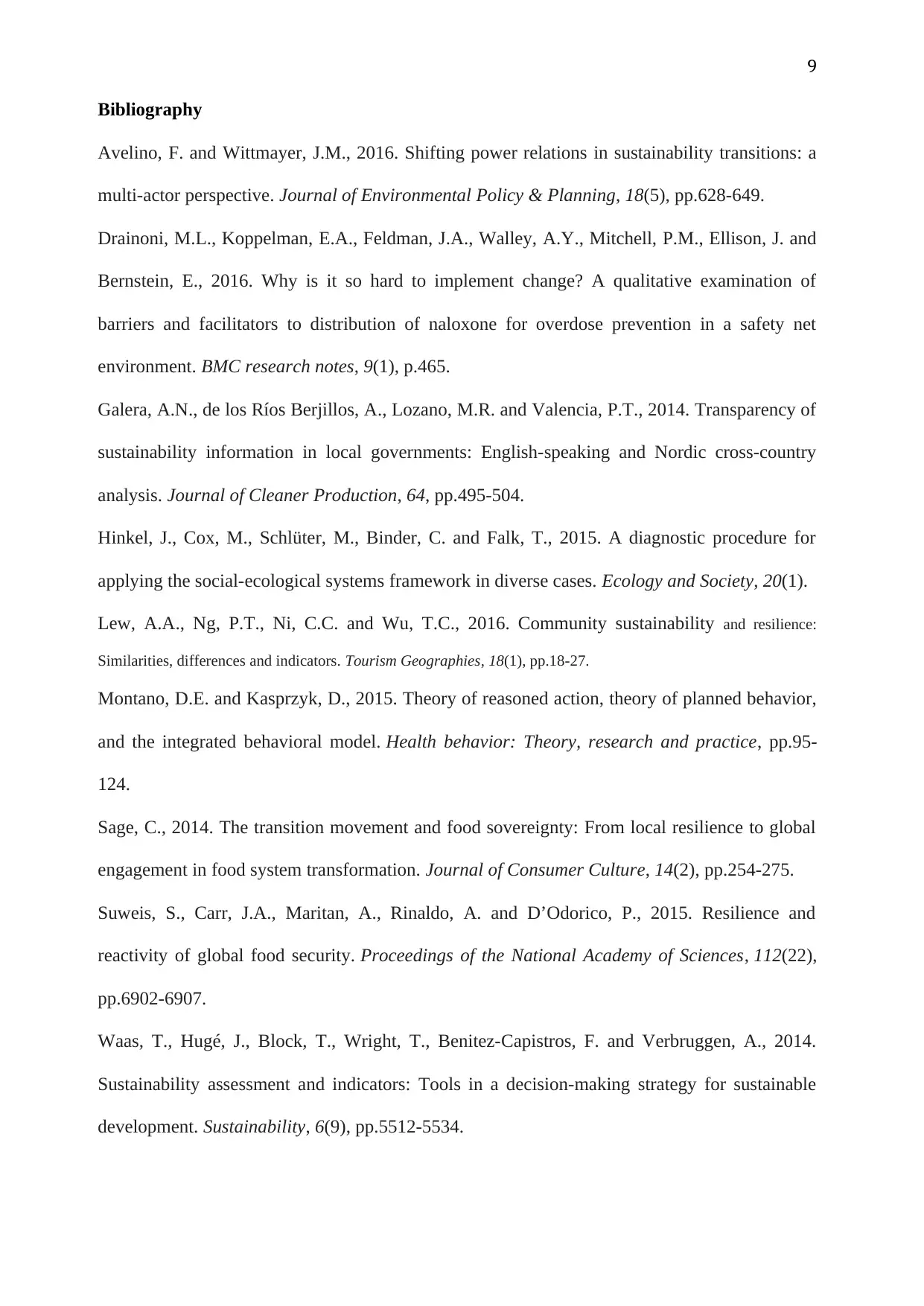
9
Bibliography
Avelino, F. and Wittmayer, J.M., 2016. Shifting power relations in sustainability transitions: a
multi-actor perspective. Journal of Environmental Policy & Planning, 18(5), pp.628-649.
Drainoni, M.L., Koppelman, E.A., Feldman, J.A., Walley, A.Y., Mitchell, P.M., Ellison, J. and
Bernstein, E., 2016. Why is it so hard to implement change? A qualitative examination of
barriers and facilitators to distribution of naloxone for overdose prevention in a safety net
environment. BMC research notes, 9(1), p.465.
Galera, A.N., de los Ríos Berjillos, A., Lozano, M.R. and Valencia, P.T., 2014. Transparency of
sustainability information in local governments: English-speaking and Nordic cross-country
analysis. Journal of Cleaner Production, 64, pp.495-504.
Hinkel, J., Cox, M., Schlüter, M., Binder, C. and Falk, T., 2015. A diagnostic procedure for
applying the social-ecological systems framework in diverse cases. Ecology and Society, 20(1).
Lew, A.A., Ng, P.T., Ni, C.C. and Wu, T.C., 2016. Community sustainability and resilience:
Similarities, differences and indicators. Tourism Geographies, 18(1), pp.18-27.
Montano, D.E. and Kasprzyk, D., 2015. Theory of reasoned action, theory of planned behavior,
and the integrated behavioral model. Health behavior: Theory, research and practice, pp.95-
124.
Sage, C., 2014. The transition movement and food sovereignty: From local resilience to global
engagement in food system transformation. Journal of Consumer Culture, 14(2), pp.254-275.
Suweis, S., Carr, J.A., Maritan, A., Rinaldo, A. and D’Odorico, P., 2015. Resilience and
reactivity of global food security. Proceedings of the National Academy of Sciences, 112(22),
pp.6902-6907.
Waas, T., Hugé, J., Block, T., Wright, T., Benitez-Capistros, F. and Verbruggen, A., 2014.
Sustainability assessment and indicators: Tools in a decision-making strategy for sustainable
development. Sustainability, 6(9), pp.5512-5534.
Bibliography
Avelino, F. and Wittmayer, J.M., 2016. Shifting power relations in sustainability transitions: a
multi-actor perspective. Journal of Environmental Policy & Planning, 18(5), pp.628-649.
Drainoni, M.L., Koppelman, E.A., Feldman, J.A., Walley, A.Y., Mitchell, P.M., Ellison, J. and
Bernstein, E., 2016. Why is it so hard to implement change? A qualitative examination of
barriers and facilitators to distribution of naloxone for overdose prevention in a safety net
environment. BMC research notes, 9(1), p.465.
Galera, A.N., de los Ríos Berjillos, A., Lozano, M.R. and Valencia, P.T., 2014. Transparency of
sustainability information in local governments: English-speaking and Nordic cross-country
analysis. Journal of Cleaner Production, 64, pp.495-504.
Hinkel, J., Cox, M., Schlüter, M., Binder, C. and Falk, T., 2015. A diagnostic procedure for
applying the social-ecological systems framework in diverse cases. Ecology and Society, 20(1).
Lew, A.A., Ng, P.T., Ni, C.C. and Wu, T.C., 2016. Community sustainability and resilience:
Similarities, differences and indicators. Tourism Geographies, 18(1), pp.18-27.
Montano, D.E. and Kasprzyk, D., 2015. Theory of reasoned action, theory of planned behavior,
and the integrated behavioral model. Health behavior: Theory, research and practice, pp.95-
124.
Sage, C., 2014. The transition movement and food sovereignty: From local resilience to global
engagement in food system transformation. Journal of Consumer Culture, 14(2), pp.254-275.
Suweis, S., Carr, J.A., Maritan, A., Rinaldo, A. and D’Odorico, P., 2015. Resilience and
reactivity of global food security. Proceedings of the National Academy of Sciences, 112(22),
pp.6902-6907.
Waas, T., Hugé, J., Block, T., Wright, T., Benitez-Capistros, F. and Verbruggen, A., 2014.
Sustainability assessment and indicators: Tools in a decision-making strategy for sustainable
development. Sustainability, 6(9), pp.5512-5534.
⊘ This is a preview!⊘
Do you want full access?
Subscribe today to unlock all pages.

Trusted by 1+ million students worldwide
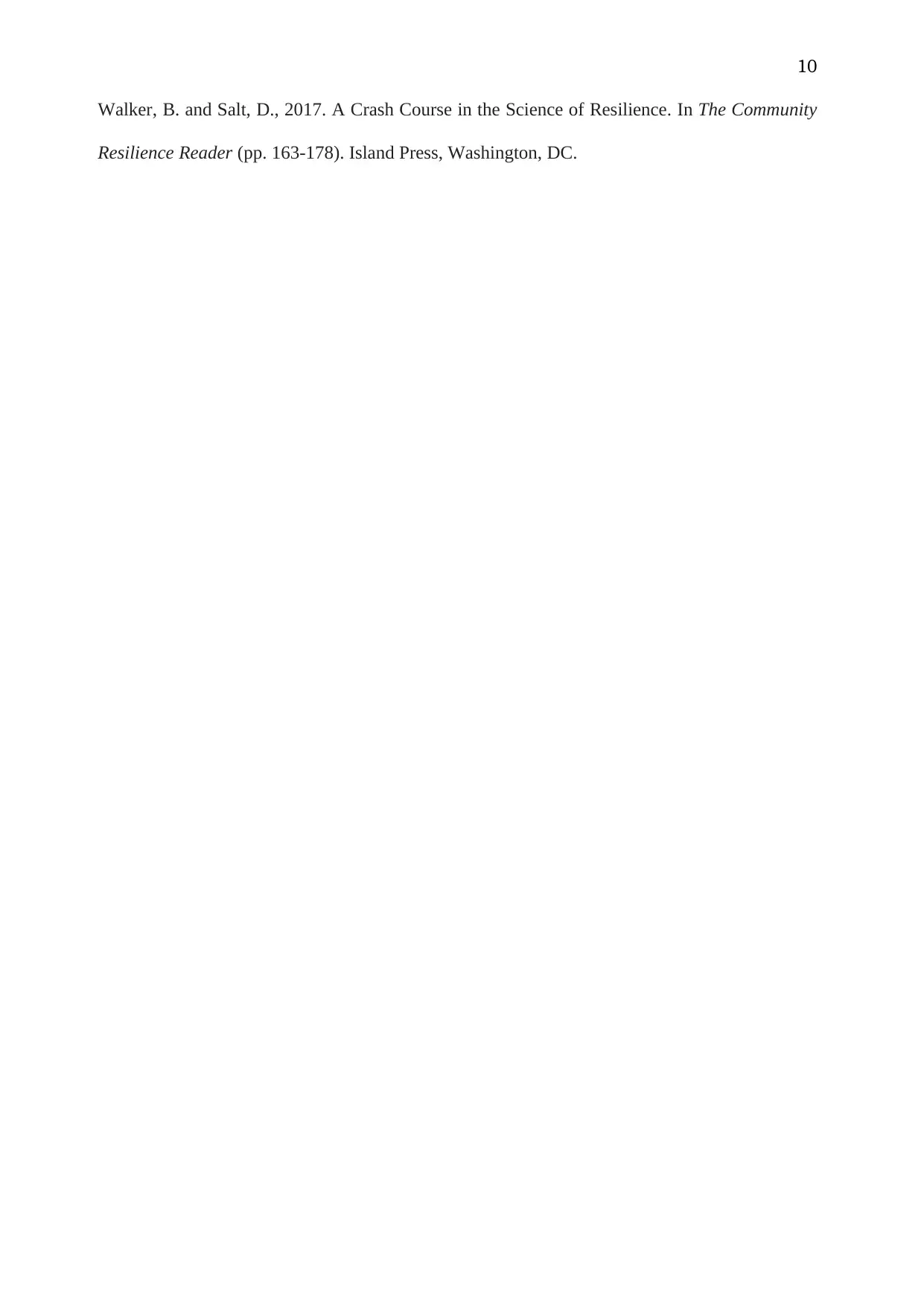
10
Walker, B. and Salt, D., 2017. A Crash Course in the Science of Resilience. In The Community
Resilience Reader (pp. 163-178). Island Press, Washington, DC.
Walker, B. and Salt, D., 2017. A Crash Course in the Science of Resilience. In The Community
Resilience Reader (pp. 163-178). Island Press, Washington, DC.
1 out of 10
Related Documents
Your All-in-One AI-Powered Toolkit for Academic Success.
+13062052269
info@desklib.com
Available 24*7 on WhatsApp / Email
![[object Object]](/_next/static/media/star-bottom.7253800d.svg)
Unlock your academic potential
Copyright © 2020–2025 A2Z Services. All Rights Reserved. Developed and managed by ZUCOL.


